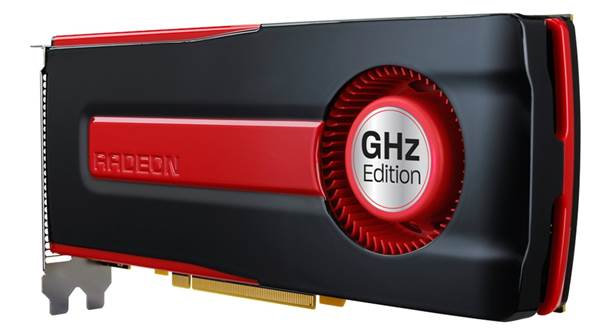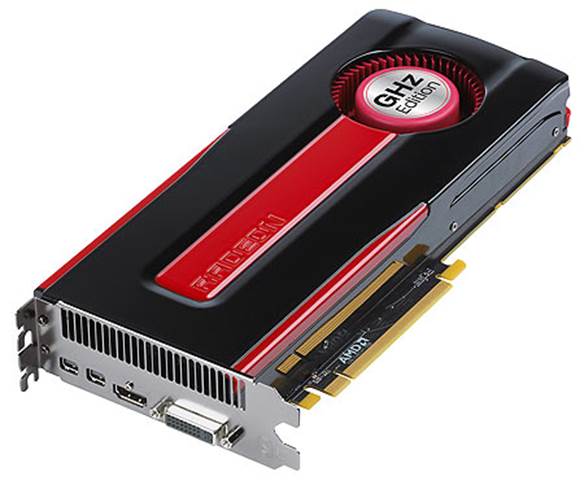AMD used to reserve the X800-series part of
its nomenclature for its most powerful single-core cards, but these days the
Radeon HD 7870 is an impressive mid-range part. It’s the most expensive model
in this test, at $301 inc VAT, and it’s got its work cut out to eclipse
Nvidia’s GeForce GTX 660.

AMD
Radeon HD 7870
The Pitcairn XT core, used to build the HD
7870, is made from an all-new architecture that’s called Southern Islands,
which is created with a 28nm manufacturing process – the same as Nvidia uses on
its Kepler-based cards. The Pitcairn core is one step down from high-end
Tahiti-based cards, and it shows in the transistor count: while the Radeon HD
7970 use 4.3 billion of them, AMD includes 'just' 2.8 billion in this core.
That’s not to say Pitcairn is lacking, it
benefits from a 1,000MHz stock speed, which is among the best here, and it also
includes 2GB of RAM. That's twice as much as you’ll find on low-end cards, and
the GDDR5 memory is managed by a 256-bit bus, wider than any of the three
Nvidia cards on test, and it’s clocked at a respectable 1,200MHz.
AMD has crammed 1,280 stream processors
into this card, and they’re packaged into twenty of AMD’s Graphics Core Next
clusters, a dozen less than is found on AMD’s top-end cards. That means each
cluster has 80 stream processors each. This card has also had a recent upgrade,
too, with a new 'Never Settle' driver - version 12.11 of AMD's Catalyst driver
- which it claims will give all of its Southern Islands cards a performance
boost of up to 15%. That’s a big leap, bought about by two major improvements:
increased efficiency in the usage of cores across the card, and enhanced memory
cache performance.
Nvidia, meanwhile, has responded to AMD’s
Never Settle program with drivers that it claims will also boost the
performance of GeForce cards by a healthy margin.
The HD 7870 may well be the most expensive
AMD card in this test, but it proved its worth in our benchmarks – especially
thanks to Catalyst 12.11’s upgrades. It clocked up 60fps in the 1,920 x 1,080
Crysis benchmark, which is three frames more than Nvidia’s GTX 660 could
manage, and the AMD card averaged 50fps in the sequel – one frame faster than
Nvidia.
The AMD card pipped Nvidia in our other two
games tests, too: its 71fps average in Just Cause 2 and 92fps average in DiRT
3, both run at Very High settings, are one frame and three frames ahead of
anything Nvidia could manage.

The
HD 7870 may well be the most expensive AMD card in this test, but it proved its
worth in our benchmarks – especially thanks to Catalyst 12.11’s upgrades
Our theoretical tests back up the HD 7870’s
real-world dominance; it averaged 83.1fps in Unigine Heaven’s DX11 test, almost
four frames more than the Nvidia card’s 79.4fps, and in 3Dmark 11 the AMD’s
combined benchmark score of 7,575 easily outpaced Nvidia’s 5,499. That's an
advantage that was also found in the performance and graphics portions of the
3Dmark 11 test.
There’s one area where AMD fell behind,
though, and that’s power consumption. With the HD 7870 installed our test rig
drew 77W from the mains, with this figure rising to 246W when stress-tested.
It’s the highest power figure this week, with the GTX 660 requiring just 224W,
and it shows in the physical build of the HD 7870: it’s the only card here that
requires two, rather than one, six-pin power plugs.
It’s a small price to pay, though, for
graphics dominance. There’s only around ten pounds between the AMD Radeon HD
7870 and Nvidia’s GeForce GTX 660 at the checkout, with AMD’s driver updates
having at least equalled to Nvidia’s own software improvements.
Yes, it's the most expensive card here, but
it's also dominant in our benchmarks. If you’re searching for game-breaking
power for less than $320, look no further than the HD 7870. If you’re looking
for the best graphics possible on a budget, this is the one to buy.
|
Details
·
Price: $301
·
Website: www.amd.com
Verdict
·
Quality: 9/10
·
Value: 8/10
|